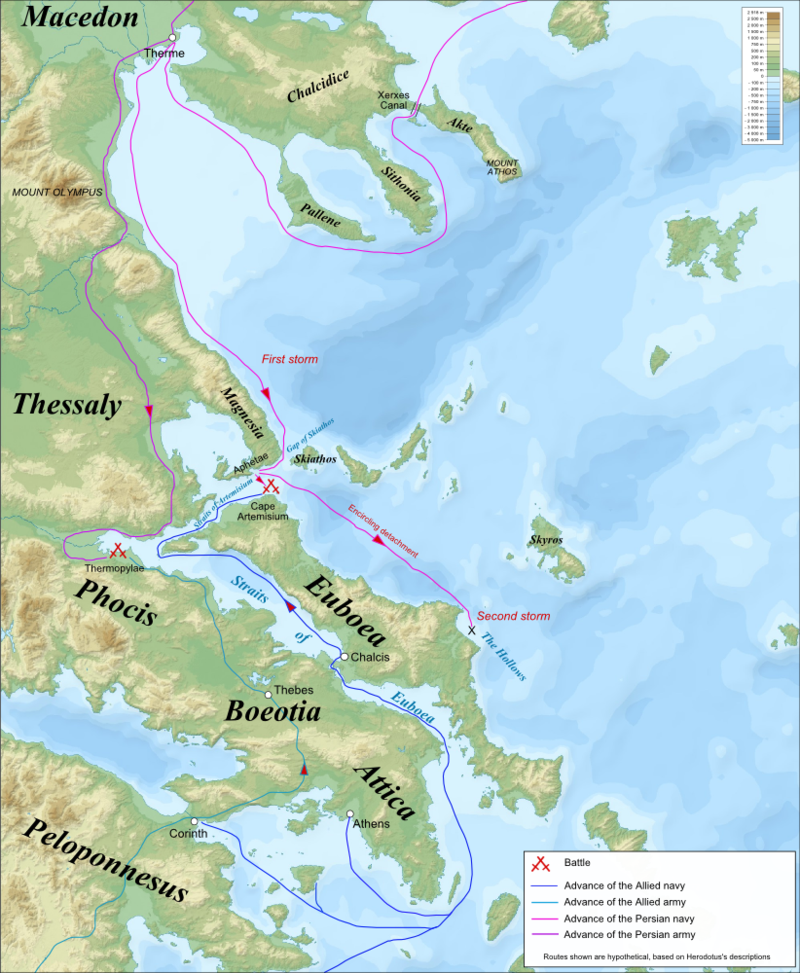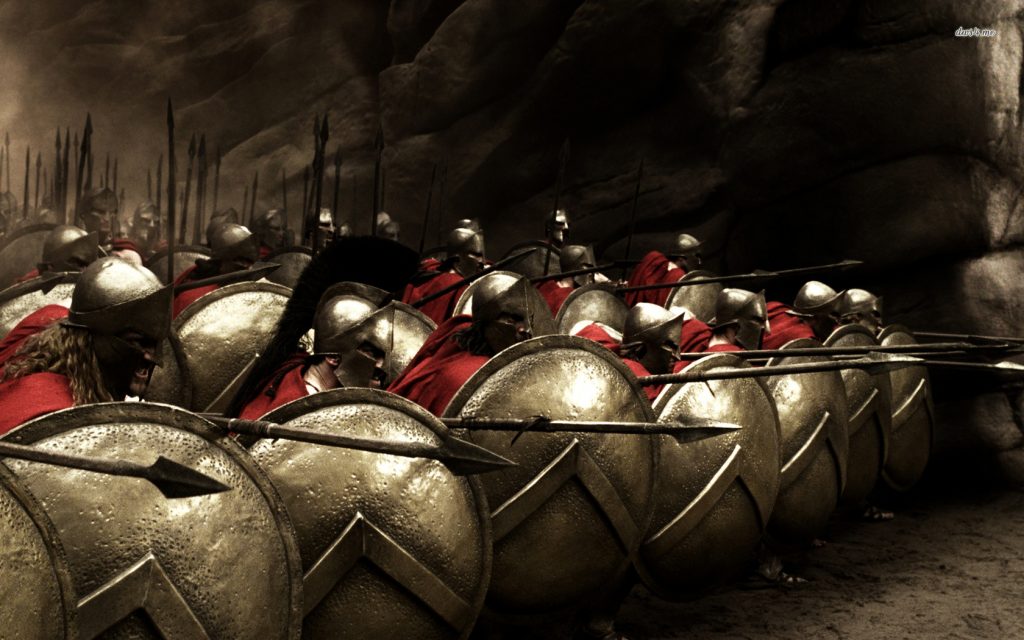
PHOTO: wallpapercave.com
In 480 BC, during what is called the Second Greco-Persian War, King Xerxes of Persia sent an army of some hundred-thousand Persian Immortals to put down the upstart city-states of Greece once and for all. His massive force set out from Persia, and the Greek city-states banned together. Greek general Themistocles had a plan to block the invasion, though, but it required the holding of one very important pass: a pass in the north of Greece named Thermopylae.
The Winds of War
Just a few years earlier, the Greek city-states of Athens and Eretria had encouraged an unsuccessful revolt against the mighty Persian Empire, called the Ionian Revolt. The revolt threatened the integrity of the then-young Persian Empire, and Darius vowed to punish everyone involved… especially those Greek city-states.
Darius sent out ambassadors to all the Greek city-states in 491 BC, demanding a tribute of “Earth and Water”. Many of the city states obliged, but not Athens! When the Persian ambassadors reached the city, they were promptly taken into custody, put on trial, and executed in a pit. Sparta was less kind. They gave Darius their regards by kicking the Persian emissary down a well.
Persia declared war on Greece, but their first few assaults, including the Battle of Marathon, were unsuccessful. Defeated, Darius withdrew back to Persia and began putting together a huge army. Unfortunately for him, just when he got home, Egypt revolted. Darius died while he was planning a march on Egypt, and the throne passed to his son, Xerxes.
Xerxes succeeded in putting down the Egyptian revolt. After which, he resolved to finish what his father started and immediately continued the preparations for the invasion of Greece.
The Two-Part Strategy

PHOTO: wikimedia
By 480 BC, Xerxes was ready to march on Greece. He gathered his forces at Sardis and then launched the invasion. Greece would be ready for him.
The route to southern Greece would require Xerxes to pass through a very narrow pass in northern Greece called Thermopylae. The pass was bounded on one side by sheer mountain cliffs, and on the other side by the ocean. The Greeks planned to stop him there.
In order to stop Xerxes from bypassing Thermopylae by sea, the Athenian navy planned to block the strait of Artemisium. The congress of Greek city-states decided this was an excellent strategy, evacuated their civilians en masse to Torezan, and set up their forces.
Some 7,000 Greek soldiers amassed at Thermopylae, headed by Spartan general, Leonidas. It took the Persians several months to reach Greece, but they reached the pass in late August. They sat at a stalemate for five days. Xerxes knew it was a trap. He knew that he couldn’t punch through the pass without sustaining a huge amount of casualties. So he waited, and waited.
Betrayal and The Battle

PHOTO: weoverflow.com
There were some one-hundred thousand Persians against 7,000 Greeks. On the fifth day of waiting, Xerxes finally decided to launch an assault on Thermopylae. The battle began with the whistling of five thousand archer’s arrows through the air. When Leonidas heard the arrows were so many they would “dim out the sun”, he simply replied: “Then we shall have to fight in the shade!”
The arrows were ineffective. The Greeks easily blocked them with their shields and helmets. After that, Xerxes sent in ten-thousand Medes and Cissians in a full-frontal assault.
The Greeks held their ground at the narrowest part of the pass in a bristling phalanx, even as the bodies piled up in screaming walls around them. Their shields and spears spanned the width of the entire pass.
“The men stood shoulder to shoulder. [The Greeks were] superior in valor and in the great size of their shields.” – Diodorus
The Greeks held the pass, rotating out men as needed to give the ones at the front of the line rest. The first wave of Persians was cut to shreds with minimal losses to the Spartans.
![The battlefield at Thermopylae [PHOTO: wikimedia]](https://historythings.com/wp-content/uploads/2016/07/1280px-Thermopylae_ancient_coastline_large-300x225.jpg)
The battlefield at Thermopylae [PHOTO: wikimedia]
Well, Xerxes was about to get the biggest break of his life thanks to one traitor: a Trachinian named Ephialtes. The man told him of a mountain path that would take him around Thermopylae. He even offered to guide the Persian army to it.
At dawn of the third day, the Phocians who were guarding the mountain path above the pass heard the rustling of oak leaves. They jumped up and sent a runner to warn the rest of the Greek soldiers, and the ones that stayed behind were cut down by Persian forces encircling the area.
The news from the runner made many of the Greeks call for surrender, but Leonidas was unafraid. He resolved to stay at the pass. He and his Spartans would hold it. He sent home most of the other Greek contingents. Only 700 Thespians, 400 Thebans, and 300 Spartans stayed behind to hold the pass off against an army that was literally a hundred times their size.
At daybreak of the third day, the Persians descended onto the tiny fighting force. The Spartans and their comrades fought ferociously as the bodies piled up around them. They fought the Persian armies until their weapons broke. Even after that, the Spartans went down fighting, fists swinging, gouging out eyes with their bare hands, kicking, even tearing into the Persian assault with their teeth.
Almost every single Greek at Thermopylae died, including Leonidas. His body was recovered a few days later by the Persians, and Xerxes ordered the body decapitated and crucified.
Aftermath
The pass was opened to the Persian army. Xerxes and his men swooped down on Plataea and Thespiae, burning and sacking as they went. The Athenian navy retreated to Salamis, but, under Themistocles, they were able to smash the Persian navy into the straits of Salamis in a decisive victory. The destruction of the Persian fleet ended the threat to the Peloponnese.
Facing possible entrapment on the Peloponnese, afraid the Greeks might burn the bridges and trap his armies in Europe, Xerxes retreated to Asia. Almost his entire army died of starvation on the way back.
Thermopylae is, arguably, one of the most famous battles in European history. It exists as a testament to courage and valor against impossible odds.
A stone lion was erected at Thermopylae to commemorate Leonidas and his men. Though they were extinguished that day under the might of the Persian Empire, their battle was not in vain, and their names have been burned into history.

